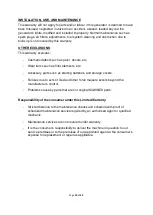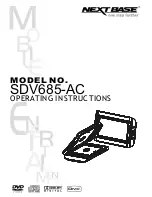
Page
8
of
23
EARTHING OF GENERATOR
Earthing of generators helps protect the user from electric shock or electrocution
which may be caused due to malfunction or breakdown. This threat to the user is
prevented by creating a path of least resistance for the electrical current to travel to
the ground which inherently absorbs the over-current or short circuit.
WARNING
FAILURE TO PROPERLY CONNECT THE EQUIPMENT TO THE
EARTHING CONDUCTOR WILL RESULT IN A RISK OF
ELECTROCUTION. CONSULT WITH A QUALIFIED ELECTRICIAN
INCASE OF DOUBT WITH THE EARTHING OF THE UNIT.
To connect the generator to an appropriate earth source, a hex
nut and an earth terminal should be used. An #8 earth wire
must be used to establish the earth path for the electrical
current. Connect the terminal of one end of the earth wire to
the frame in-between a spring washer and two hex nuts then
tighten the nuts securely. The other end of the wire should be
bolted securely onto an appropriate ground source.
Portable generators are inherently more dangerous than fixed
generators as they are not permanently earthed. Therefore,
appropriate measures must be taken to properly set up the
earthing of the generators. The National Electric Code (NEC)
contains several methods that can be used to establish a
suitable earthing source for the portable generator unit. Some
examples of these methods are summarised in the following
points.
•
A suitable earthing source can be a metal underground water pipe in direct
contact with the earth at a minimum depth of 10 feet.
•
If a pipe is unavailable, an 8-foot length pipe or rod can also be used as a
suitable earthing source.
•
Pipes used as an earthing source must be 3/4 inch trade size or larger with a
non-corrosive outer surface.
•
Steel or iron rods must be at least 5/8 diameter, and at least 1/2 inch diameter
for non-ferrous rods. Ensure that the non-ferrous material used is earthing
suitable.
•
Rod or pipe should be driven 8 feet deep into the ground. If a rock bottom is
met within 4 feet, the rod or pipe can be buried in a trench.









































